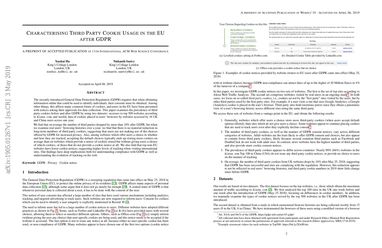Characterising Third Party Cookie Usage in the EU after GDPR
The recently introduced General Data Protection Regulation (GDPR) requires that when obtaining information online that could be used to identify individuals, their consents must be obtained. Among other things, this affects many common forms of cookies, and users in the EU have been presented with notices asking their approvals for data collection. This paper examines the prevalence of third party cookies before and after GDPR by using two datasets: accesses to top 500 websites according to Alexa.com, and weekly data of cookies placed in users' browsers by websites accessed by 16 UK and China users across one year. We find that on average the number of third parties dropped by more than 10% after GDPR, but when we examine real users' browsing histories over a year, we find that there is no material reduction in long-term numbers of third party cookies, suggesting that users are not making use of the choices offered by GDPR for increased privacy. Also, among websites which offer users a choice in whether and how they are tracked, accepting the default choices typically ends up storing more cookies on average than on websites which provide a notice of cookies stored but without giving users a choice of which cookies, or those that do not provide a cookie notice at all. We also find that top non-EU websites have fewer cookie notices, suggesting higher levels of tracking when visiting international sites. Our findings have deep implications both for understanding compliance with GDPR as well as understanding the evolution of tracking on the web.
PDF Abstract